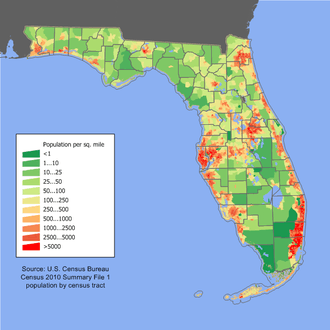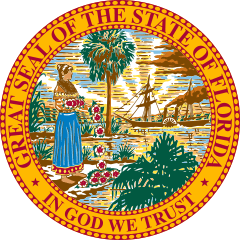Culture of Florida
The culture of Florida is similar to the rest of American Southern culture, but as a coastal state, Florida’s urban culture has also been influenced by immigrant populations, especially those from Europe and Latin America. Florida was a founding member of the Confederacy, but is now a melting pot as well as an international crossroad.
| This article is part of a series on the |
| Culture of the United States of America |
|---|
| Society |
| Arts and literature |
|
| Other |
| Symbols |
|
United States portal |
Modern-day Florida, from the later half of the 20th century until today, has been heavily influenced by the cultures of people moving in from foreign countries and other parts of the United States. The state's close proximity to the ocean influences many aspects of Florida culture and daily life. As one of the Southern states, Florida has also long been influenced by Southern culture. However, the culture of the southern half of Florida does not exhibit as much of the Southern culture found in North and Central Florida. The Miami area especially has been culturally influenced by Latin and Caribbean immigration. Characteristics such as a Southern drawl still remain in North Florida, Central Florida, rural inland Florida, and rural southern Florida. Florida culture is also influenced by tourism, an important industry in the state.

Cuisine
Southern Florida has been more influenced by infusions from the various cuisines of the Caribbean, South America, and Europe compared to Northern Florida. However, the cuisine of the Southern United States is popular throughout the whole state. Florida is most often associated with seafood, key lime pie and Floribbean cuisine. Citrus production is a major industry and citrus fruits are widely consumed. Tropical fruits are grown in South Florida and are widely used in Florida cuisine. Barbecue is especially popular throughout the state, where many barbecue competitions are held annually. The development of Florida cuisine has drawn on the cuisines of the southeastern United States, the Bahamas, Colombia, Spain, Cuba, and the rest of the Caribbean, as well as being influenced by nationwide and worldwide trends. Florida attracts immigrants from places around the world as well, many of whom bring their native cuisine with them.
Economic trends
Florida's population increases annually more rapidly than that of most states. The main economic driver for Florida is tourism, so hotels, restaurants, leisure activities and other tourism-related activities are economically important. Many people from other states, especially Americans from the Northeast and Midwest, retire in Florida, driving home construction, infrastructure expansion, as well as the banking and financial planning industries. Recreational and commercial fishing have been economically important in Florida for over a century.
Florida is also an important agricultural state, producing large amounts of vegetables, fruits, cattle, and dairy products. Light manufacturing has recently increased in Florida, and a number of companies have moved their headquarters to the state, attracted by lower taxes and less regulations.
Languages
As of 2005 , 74.54 percent of Florida residents age 5 and older spoke English at home as a first language, while 18.65 percent spoke Spanish, and 1.73 percent of the population spoke French Creole (predominantly Haitian Creole). French was spoken by 0.63 percent, followed by German at 0.45 percent, and Portuguese at 0.44 percent of all residents. Also, Italian comprised 0.32 percent, while Tagalog made up 0.30 percent of speakers, Vietnamese was at 0.25 percent and Arabic at 0.23 percent. In all, 25.45 percent of Florida's population age 5 and older spoke a language other than English.[1]
Florida's public education system identifies over 200 first languages other than English spoken in the homes of students. In 1990, the League of United Latin American Citizens (LULAC) won a class action lawsuit against the state Florida Department of Education that required educators to be trained in teaching English for Speakers of Other Languages (ESOL).
Literature
Music
Florida is home to several unique music genres including Florida breaks and Miami bass.
Religion
According to the Pew Research Center's Religious Landscape Study, Florida's populations is 70% Christian (the largest sect of which is "Evangelical Protestant"), 6% non-Christian, and 24% "No Religion" or "Nothing in Particular." The latter categories, according to the same study, are rising over time, which is consistent with trends nationwide.[2]
Sports and recreation
Sports in Florida include professional teams in all major sports, many minor league professional teams, Olympic Games contenders and medalists, collegiate teams in major and small-school conferences and associations, and active amateur teams and individual sports.
The state has teams in each of the major professional sports leagues: there are three National Football League (NFL) teams, the Miami Dolphins, and Tampa Bay Buccaneers, and the Jacksonville Jaguars; two Major League Baseball (MLB) teams, the Miami Marlins and the Tampa Bay Rays; two National Basketball Association (NBA) teams, the Miami Heat and the Orlando Magic; and two National Hockey League (NHL) teams, the Florida Panthers and the Tampa Bay Lightning. Additionally, Major League Soccer has one team, Orlando City SC, and plans to add a second team, Inter Miami CF in 2020.
Florida also has an abundance of outdoor recreational activities. Outdoor activities include hiking, surfing, and hunting. Notable auto-racing tracks include: Daytona International Speedway, Homestead-Miami Speedway, Sebring International Raceway, Streets of St. Petersburg, and Walt Disney World Speedway.
See also
References
- "Most spoken languages in Florida". Modern Language Association. Retrieved 2008-10-06.
- . Pew Research Center http://www.pewforum.org/religious-landscape-study/state/florida/. Missing or empty
|title=(help)
